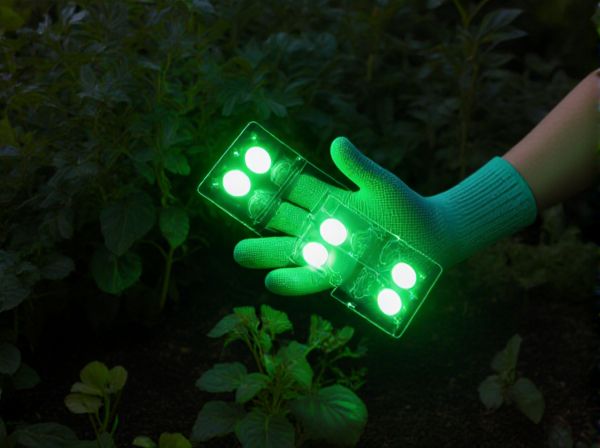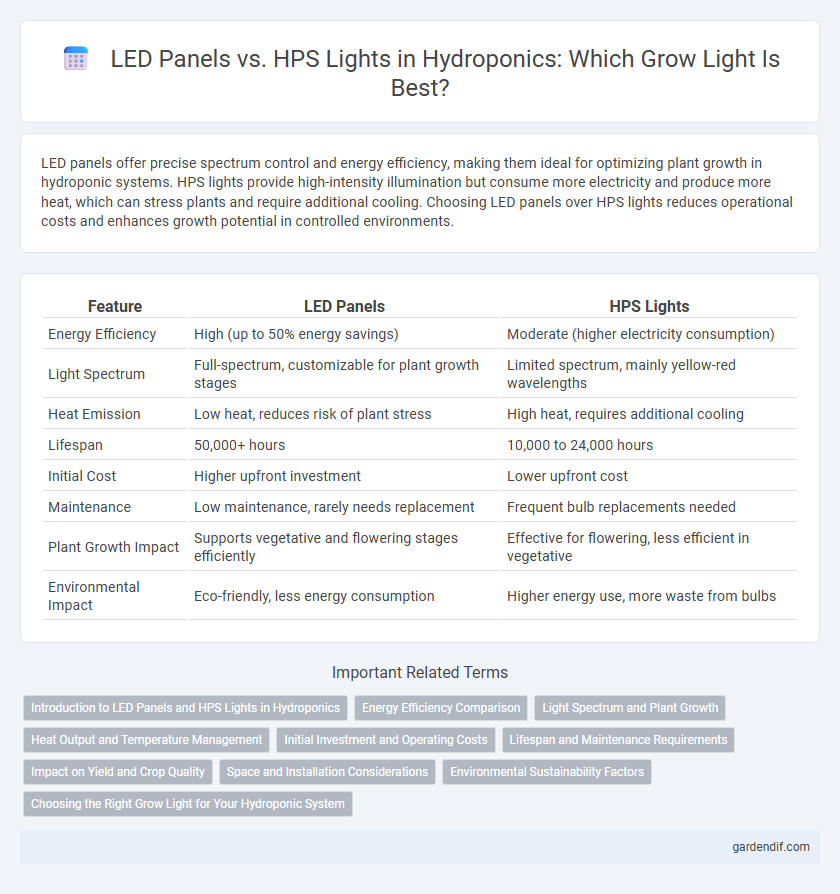
LED Panels vs HPS Lights Illustration
LED panels offer precise spectrum control and energy efficiency, making them ideal for optimizing plant growth in hydroponic systems. HPS lights provide high-intensity illumination but consume more electricity and produce more heat, which can stress plants and require additional cooling. Choosing LED panels over HPS lights reduces operational costs and enhances growth potential in controlled environments.
Table of Comparison
| Feature | LED Panels | HPS Lights |
|---|---|---|
| Energy Efficiency | High (up to 50% energy savings) | Moderate (higher electricity consumption) |
| Light Spectrum | Full-spectrum, customizable for plant growth stages | Limited spectrum, mainly yellow-red wavelengths |
| Heat Emission | Low heat, reduces risk of plant stress | High heat, requires additional cooling |
| Lifespan | 50,000+ hours | 10,000 to 24,000 hours |
| Initial Cost | Higher upfront investment | Lower upfront cost |
| Maintenance | Low maintenance, rarely needs replacement | Frequent bulb replacements needed |
| Plant Growth Impact | Supports vegetative and flowering stages efficiently | Effective for flowering, less efficient in vegetative |
| Environmental Impact | Eco-friendly, less energy consumption | Higher energy use, more waste from bulbs |
Introduction to LED Panels and HPS Lights in Hydroponics
LED panels and HPS lights are two primary lighting options used in hydroponic systems to optimize plant growth and yield. LED panels offer energy-efficient, customizable light spectra that promote photosynthesis while generating less heat, making them ideal for indoor hydroponic setups. In contrast, HPS lights emit a broad-spectrum light with high intensity but consume more electricity and produce significant heat, requiring additional cooling measures in hydroponic environments.
Energy Efficiency Comparison
LED panels for hydroponic systems consume up to 50% less energy compared to HPS lights while providing equivalent or higher light output tailored for plant growth. The reduced heat emission from LED panels decreases cooling costs, enhancing overall energy savings in indoor farming environments. HPS lights, despite their high lumen output, operate with lower energy efficiency and generate excess heat, requiring additional power for climate control.
Light Spectrum and Plant Growth
LED panels provide a customizable light spectrum that closely mimics natural sunlight, enhancing photosynthesis and promoting faster plant growth in hydroponic systems. HPS lights emit a broader spectrum with high intensity in the yellow and red wavelengths, which supports flowering and fruiting stages but can generate excessive heat. Optimizing light spectrum with LEDs improves energy efficiency and plant health, making them ideal for balancing vegetative growth and flowering in hydroponic cultivation.
Heat Output and Temperature Management
LED panels generate significantly less heat compared to HPS lights, reducing the risk of heat stress and allowing for closer placement to plants in hydroponic systems. Lower heat output from LED panels diminishes the need for extensive cooling infrastructure, improving energy efficiency and maintaining optimal root zone temperatures. Proper temperature management with LED technology promotes healthier plant growth and consistent yield in controlled-environment agriculture.
Initial Investment and Operating Costs
LED panels typically require a higher initial investment compared to HPS lights but offer significantly lower operating costs due to enhanced energy efficiency and longer lifespans. HPS lights have a lower upfront cost but consume more electricity and require frequent bulb replacements, increasing long-term expenses. Choosing LED panels reduces heat output, which can lower cooling costs, further optimizing overall operational savings.
Lifespan and Maintenance Requirements
LED panels offer a significantly longer lifespan, typically ranging from 50,000 to 100,000 hours, compared to HPS lights, which usually last around 10,000 to 24,000 hours. Maintenance requirements for LED panels are minimal due to their solid-state design and lower heat output, reducing the need for frequent replacements and cooling system upkeep. In contrast, HPS lights demand more regular bulb changes and intensive cooling measures, increasing overall maintenance efforts and costs in hydroponic systems.
Impact on Yield and Crop Quality
LED panels enhance crop yield by delivering targeted light spectra that optimize photosynthesis, resulting in faster growth cycles and higher-quality produce compared to traditional HPS lights. HPS lights emit broader, less efficient light spectra that can increase heat stress, potentially reducing overall crop quality and increasing energy consumption. Studies show that hydroponic systems using LED technology achieve up to 30% greater yield with improved nutrient density and color vibrancy in harvested crops.
Space and Installation Considerations
LED panels offer a compact design that maximizes vertical growing space and simplifies ceiling mounting compared to bulky HPS lights, which require more clearance and specialized fixtures. The lower heat output of LED panels reduces the need for extensive ventilation systems, enabling closer plant placement and more efficient use of limited indoor spaces. HPS lights, while effective, often demand additional structural support and higher installation costs due to their size and cooling requirements.
Environmental Sustainability Factors
LED panels consume significantly less energy than HPS lights, reducing carbon footprints in hydroponic systems. Their longer lifespan and lower heat emission minimize waste and cooling requirements, enhancing overall sustainability. The reduced electricity demand and improved energy efficiency make LED panels an environmentally favorable choice for sustainable hydroponic farming.
Choosing the Right Grow Light for Your Hydroponic System
LED panels offer energy-efficient, customizable spectrum options ideal for hydroponic systems, promoting faster plant growth and higher yields with lower heat output. In contrast, HPS lights provide intense, broad-spectrum light but consume more electricity and generate significant heat, potentially requiring additional cooling. Selecting the right grow light depends on factors like energy costs, crop type, space constraints, and budget, making LED panels increasingly preferred for modern, sustainable hydroponic setups.
LED Panels vs HPS Lights Infographic

 gardendif.com
gardendif.com